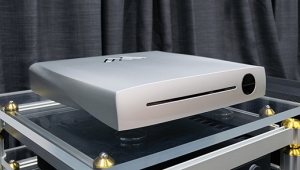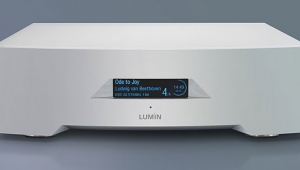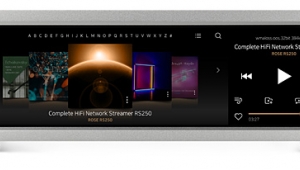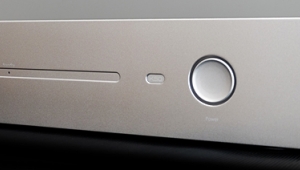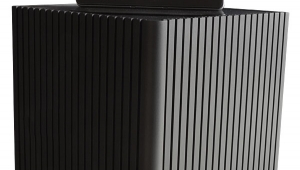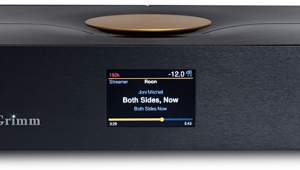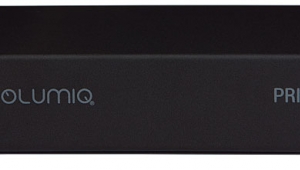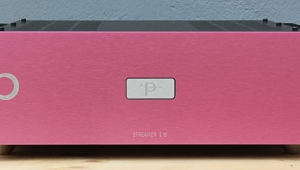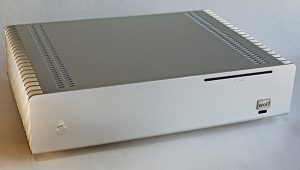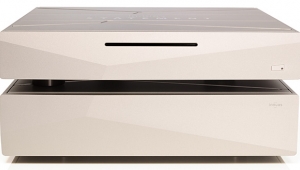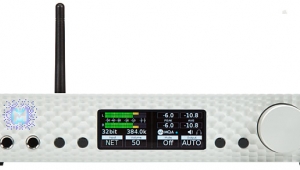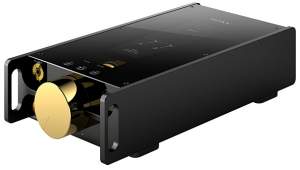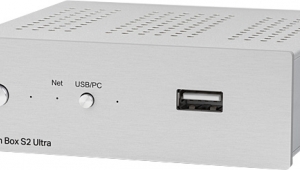| Columns Retired Columns & Blogs |
T+A Music Player Media Streamer Page 3
Tapping your way forward and back along these limbs, testing stations along the way, and hitting plenty of dead ends—it can all be a slow and tedious process. But if you've got some time on your hands, it can also be a lot of fun. Somehow, I ended up on a great sunny-side-up station broadcasting from Guyana with a fast-talking DJ playing local music. Another branch yielded a station that broadcasts real birdsong 24 hours a day. Drove the cats wild.
vTuner: 100% Generation Disco Funk
But more often than not, I was frustrated with most stations' low streaming rates and the pain of having to scroll manually back and forth through thousands of choices. I decided to fire up T+A's vTuner webpage, created exclusively for the MP. The first thing vTuner asks for is the 12-digit MAC address of your particular MP sample so it can find it on your network. Once you've input this (it's accessible via the set-up menu) and your e-mail address and have created a password, you're taken to a screen that lets you sort the 13,000 or so stations by format, location, language, genre, streaming rate, popularity, etc. You can also manually search for a station directly. I entered "Technicolor Web of Sound," the name of one of my favorite Web stations (and which I named as a "Record To Die For" in February 2005), and there it was, complete with a button to add to my "Favorites" list. The station information was transferred over the network to my "Favorites/60s Pysch" folder on the MP, and a few seconds later it was up and running with a solid 128kHz datastream. Sorting the "Oldies" category by "best-sounding stream" returned a Paris station called "100% Generation Disco Funk," which topped the list at 256kHz.
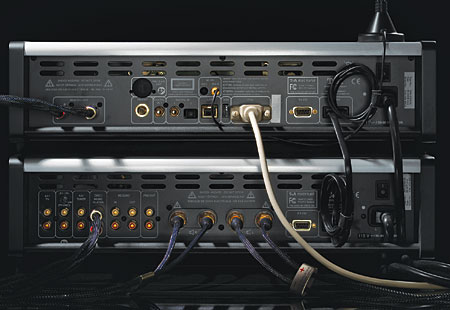
It turned out that the fastest way to set things up was to preview the stations on my computer before adding them to the MP. Bottom line: The MP's front-panel display will get you there steady and sure, but the vTuner webpage is the way to go. Using Google along with recommendations from music websites and blogs helped me quickly establish a focused list of usable stations.
When a station is chosen, the MP not only displays the station name, but also the title and artist of the song then playing, along with the streaming rate and buffer status. With the compromised sound quality of most Internet radio streams, discerning listeners will likely use such sources for one of two things: background music, or as tools for finding music to then buy in full resolution, which is where the artist and song data come in handy. But if you find an Internet radio station you really like, put a padlock on your wallet.
Compared to What?
The MP has few direct competitors, but I suspect this situation is temporary. By the time you read this, Naim should have just released in the US the Naim Uniti ($3750), which mimics the MP in features and price, and also has an optional phono stage. However, the Naim is too new to be included here; after pondering a few CD players that share only the MP's more retro qualities, John Atkinson, who likes comparing any product under review to known benchmarks, suggested focusing on the networking and DAC capabilities of a previously reviewed product.
Assistant Editor Stephen Mejias arranged for Logitech to send a Slim Devices Transporter, which, with half the T+A Music Player's functionality at half the price ($1999), was very favorably reviewed by Wes Phillips in the February 2007 issue. Though the Transporter lacks a CD drive and FM tuner, it boasts a top-notch DAC and a variety of networking and switching options, including Internet radio, as well as streaming from your digital music library, or online services such as Pandora and Rhapsody.
The Transporter's Web-browser interface is quite slick, especially compared to the old-school look of T+A's vTuner Web portal. The Transporter also does a better job of integrating multiple sources, such as your iTunes music library or favorite streaming services. But this is available only if you use a computer to run the show. One feature of the MP's Web interface, its ability to sort Web stations by streaming bit rate, gave the MP a useful advantage in this important area.
The Logitech and T+A devices use similar approaches in their built-in displays and operation via the front panel or remote control, so there was no clear winner in terms of user interface. The Transporter's display is more easily configurable, and also includes various digital metering modes, but both took about the same amount of time to set up and learn to operate.
Though it seems anathema to use Web radio as a signal source to compare the sound qualities of two audiophile products, I decided to start there in order to address the concerns of readers such as Peter DeBoer (quoted at the beginning of this review). Both products made it easy to "tune in" the same Web stations, and their sound quality was rather close. But the T+A consistently offered a slightly more natural and open top end, which removed some of the steely, compressed, and hollow-sounding gloss generally exhibited by compromised bitstreams. The MP also tended to buffer more of the signal, which meant that it was always a few seconds behind the Transporter when I compared them head to head. I locked in TechWebSound.com on both devices at a measly 128kbps and found each surprisingly listenable. Yes, this sounded no better than really good MP3 audio, but it put to rest my doubts about Web radio's potential to deliver satisfying music—let's hope the economic and political issues can be worked out and the bit rates increased.
Next, I connected the digital output from the Sooloos Music Server to the S/PDIF inputs of the Transporter and MP, and wandered through a variety of musical styles. First up was the recent album by Hector Zazou, In the House of Mirrors (CD, Crammed Discs Craw 47), released late last year just weeks after Zazou's untimely death. The album features master Indian musicians recorded in Mumbai, then processed and "reflected" by Zazou to create a stunning meditation on the sound and expressiveness of each acoustic instrument. Both DACs made beautiful music with the Sooloos; I'd be hard-pressed to tell one from the other on any given day. But relentless further listening revealed less hardness, along with more subtle detail and life in the higher frequency ranges, that ultimately tipped me in the T+A's favor. The MP also produced a slightly tighter bass, which for me was an advantage. Once I got a handle on these differences, they became easier to detect with each new recording. For example, listening to Jon Hassell's latest, Last Night the Moon Came Dropping Its Clothes in the Street (CD, ECM 2077), with its long-tapering ambient fades, the T+A consistently rendered the quieter textures with more character and detail.
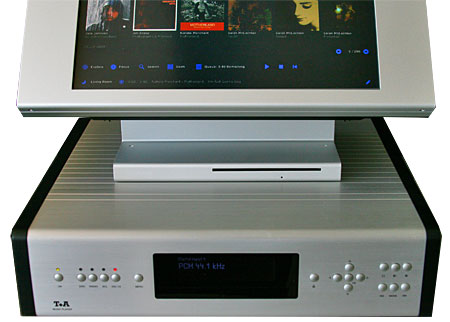
It seemed logical to compare the CD transport of the MP to the hard drive of the Sooloos, which was still hooked up to the MP's DAC via S/PDIF. After first hours, then days of listening for differences, comparing the disc in the MP and the same material from the Sooloos's hard drive, I concluded that the DAC was a leveling factor here: they sounded equally impressive. Comparing the MP playing either a CD or an uncompressed music file from iTunes vs the Sooloos using its own internal RME DAC, small differences crept back into the equation that ultimately favored the MP—which, not surprisingly, again had a more natural top end and tighter bass. As Sooloos now offers their Controller with an S/PDIF connection, without the need for the Sooloos DAC in the system, this is a match made in digital heaven.
The Right Choices?
For the music lover who listens to both CDs and downloads, T+A elektroakustik has created a timely and carefully thought-out bridge product with serious audiophile pretensions—no matter the source, the Music Player's DAC easily held its ground and made beautiful music. My only reservation is that I still find a small alphanumeric screen and remote control an awkward way to find potent digital sources and their thousands of choices of artist, song, album, and show. But I'm probably fussier than most about this issue, which is easily resolved by using the MP's excellent DAC tethered to a music server with its own graphic interface, or controlled through the MP's RS-232 port with a Crestron or similar touchscreen controller.
In the end, how to classify the T+A Music Player? Flip a coin: heads it's an excellent-sounding CD player and DAC that will keep up as your online listening habits evolve, or tails it's a Web-enabled control center and streamer with top-notch DAC that also plays your CDs. Either way, I think T+A has made the right choices for a component intended to anchor a modern digital system—especially for the customer with one foot in downloads and the other in discs. Mr. DeBoer? You should be pleased.
- Log in or register to post comments
